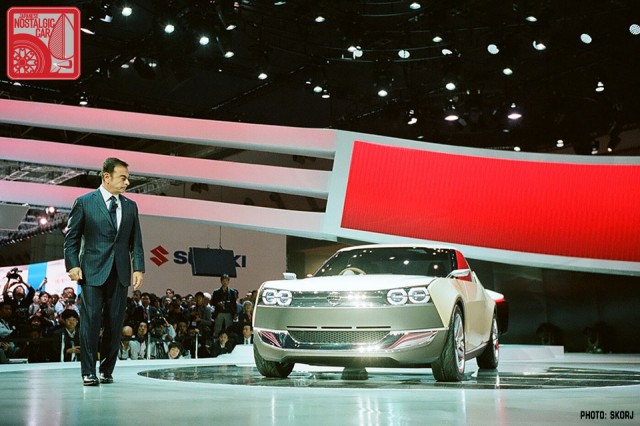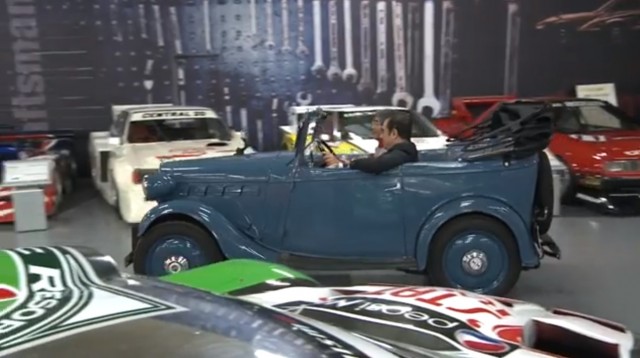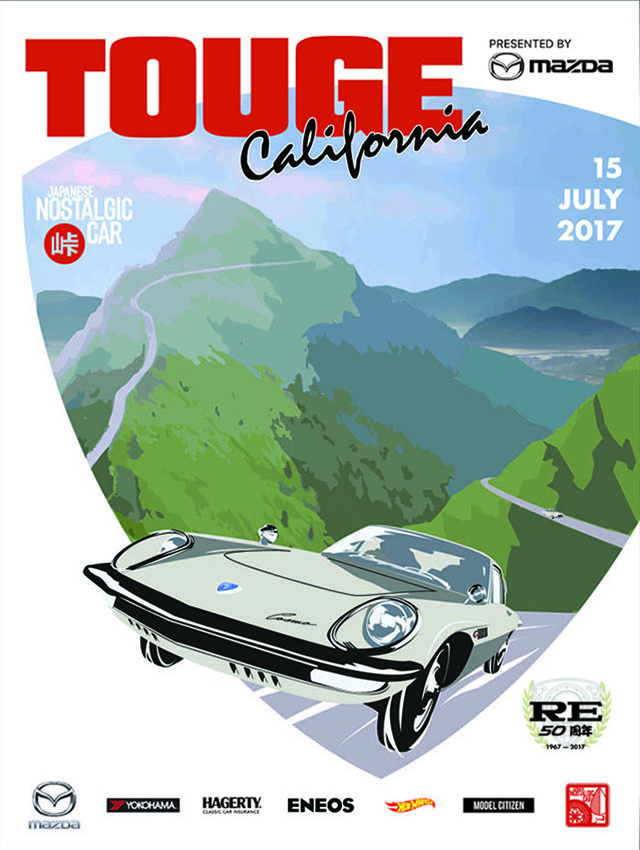For sixteen years Carlos Ghosn was Nissan’s CEO, bringing the company back from the brink of bankruptcy with his brand of extreme budget-slashing. Today, Ghosn announced that he will resign his post effective April 1.
Ghosn joined Nissan in 1999, after the Renault-Nissan Alliance was formed to save Nissan from its cash-hemorrhaging ways. Lebanese by ethnicity, raised in Brazil, and a French citizen, Ghosn rose through the ranks of Michelin and Renault, eventually becoming the first non-Japanese Nissan CEO in 2001.
Hero or Villain?
Despite its financial troubles Nissan, one Japan’s largest companies and most famous brands, occupied a special place of pride among its citizenry. Some industry watchers heralded Ghosn as a savior for rescuing Nissan from itself, while others watched in shock as “Le Cost Killer,” as he was nicknamed, wiped out decades, if not centuries, of Japanese business practices.
Before Ghosn, lifetime employment was a guarantee at large companies like Nissan or Toyota. Companies also nurtured a massive network of suppliers, many of which were redundant, mom-and-pop shops making the same part.
To the Western observer, it may seem ridiculous to make a couple hundred widgets at a time via an expansive network of family owned shops, instead of simply sourcing a few hundred thousand from one big supplier. There’s a very important reason for this, though: In Japan, companies are expected to be, above all, good citizens, a provider of jobs, training, and societal structure, bolstering the economy and keeping crime and destitution off the streets. When a part became obsolete, the company would often retrain these family-owned businesses or give them another contract.
Nissan had over 3,000 suppliers when Ghosn became CEO, and his first order of business was to slash, consolidate and squeeze them relentlessly to bring down costs. This was unthinkable to most Japanese at the time, and jolted the culture. Much ink was spilled analyzing what Nissan’s moves meant for Japan’s future.
Still, Ghosn’s moves likely gave Nissan continued existence, and by 2000 Nissan went from $6.5 billion in the red to $2.7 billion in profits. Perhaps the company did need Ghosn’s shakeup to survive. Or maybe they would have clawed their way back to profitability another way. Unless someone invents a machine to travel to alternate dimensions, we’ll never know.
However, despite all the aged gearheads rocking vintage Skylines and Fairladys at vintage car shows in Japan, the general sentiment among enthusiasts there was summed up thusly by our friend Katsuyuki Maehara, owner of several award-winning classic cars: “It’s a French company with a Japanese name.”
The Enthusiast’s Lament
We were told by a Nissan employee once that the Zama warehouse was kept on the down low for almost a decade because they were afraid Ghosn would sell everything off to save some yen. In 2012, Ghosn visited it for what appears to be the first time.
For the enthusiast, much was lost under Ghosn’s term. The Skyline GT-R, Z, Silvia, and many others were killed off. Some came back, but gone are the days when Nissan would at least attempt to inject some spirit into every model in the lineup. But hey, we got the Murano CrossCabriolet thanks to Ghosn’s wife, who demanded the model’s production. If we only could’ve put a bug in her ear about the IDx.
Today, Nissan’s lineup consists largely of shared platforms, engines, and the dreaded continuously variable transmissions. While it’s true the company is seeing an unprecedented near-10 percent US market share and record profits, one can’t help but cry for the part of Nissan’s soul that was lost in the process.
Mention to any Japanese engineer, product planner or accountant working at Nissan about the Safari Rally Bluebird, the Hakosuka GT-R at Fuji Speedway, or the Super Silhouette Turbo Corps and they’ll understand. We’ve never met Ghosn, but we’d bet he never knew of them before he took the job. Even if he did see Nissan as something more than a fleet of container ships unloading hordes of econoboxes across the world, he has certainly run it as if that’s exactly what he believed.
What’s Next
Ghosn will retain a chairman position at Nissan, but the CEO position and day-to-day management of the empire will be taken over by Hiroto Saikawa, a life-long Nissan employee who joined right out of university in 1977.
Saikawa is said to be just as zealous a cost-cutter as Ghosn, an aggressive and results-oriented leader. He helped Ghosn take apart the network of suppliers and is described as someone who isn’t afraid to make tough decisions for the sake of improving efficiency. “There is no difference between what I think and what he thinks,” Ghosn said of Saikawa last October. This doesn’t appear to bode well for enthusiasts, but there’s one glimmer of hope: if Saikawa graduated in 1977, he remembers the Hakosuka.
So why the move now? “You don’t make this kind of changes at a moment of crisis,” Ghosn told Bloomberg. “You make the changes at a moment when the company is doing well, when the company is healthy, when the company is not facing a big crisis, which is the case today.”
For his part, though, Ghosn will still retain his positions as both chairman and CEO of Renault and the Renault-Nissan Alliance as well as their newly acquired company as of four months ago. It’s pretty hard to be in charge of three global automakers at once, so we understand why Ghosn has chosen to hand over the reins. Now, to save Mitsubishi.









So he scheduled to resign effective April 1…………Aprils Fools!
In Japan, the fiscal year starts on April 1st. People start on that day, finish on March 31st. Pretty much everything runs on the business calendar. More likely he will finish on March 31st officially. Possibly be available on the 1st to announce the new suit. Not that any of this matters…
Meh.
Nissan stopped being important to me a long time ago. There are only two cars in their current USA line that I would even consider owning, and I cannot afford either of them, nor do they fit my needs for fun daily transport. (370Z NISMO and GTR)
We need a spiritual successor to the original 510. A bargain basement BMW 3 series so to speak, that is reliable, fun to drive, and affordable.
OH, and no CVT, thank you very much.
I’ve been hawking that 510 thing for years.
We enthusiasts want cars that don’t sell. I’m not surprised that the retro-510 thing (had a lot of F-10 in it) wasn’t made. It would have been a huge flop; buyers don’t want cars, much less sporty, rear-drive economy cars.
Save Mitsubishi? The same way he did Nissan? Looks like he’s already started with the Eclipse Crossover.
Shame there’s such a negative undertone to this piece. Without Ghosn there may not be a Nissan at all right now, let alone one to have a good moan about its product line.
Without the profits Ghosn was able to help the company generate, we would probably not have the 350Z and 370Z or R35 Nissan GT-R at all, so I’m not sure what the line about Ghosn “killing the GT-R and Z” is about. Yes, the GT-R has separated from the Skyline model range but it still exists, and the Z was actually revived under Ghosn – the 300ZX had disappeared a few years before he even joined.
And while it’s fun to imagine what a company entirely run by enthusiasts would look like (the actual answer here is “unsuccessful”), Nissan has made some incredibly important launches since Ghosn took over too, getting the jump on some markets that are now considered vital for all carmakers: think Juke and Qashqai/Rogue.
With the Juke in particular there’s no accusing Nissan of being too French – that’s a stereotypically weird Japanese car through and through, the sort that may never have been launched outside of Japan in the past. For me Jukes will be seen little different to existing JNC oddities like the Nissan EXA Canopy or the shooting brake-style Datsun Cherry Coupe.
CVT? Nissan had been using it in various models since the early 1990s, and since it’s more the preserve of budget cars, boring sedans and SUVs in Nissan’s range, and not Zs and GT-Rs, I’m not sure it’s worth complaining about just yet.
I love this site, and I love most of the articles on it, but pining for the good old days through rose-tinted spectacles is rarely productive and arguably the opposite – just look at what an unrealistic expectation of bringing back the past has done for the political situations on both sides of the pond right now…
The fact is, Nissan has remained in profit since Ghosn took over, and a company in profit is infinitely more likely to produce the kind of cars we’d like to see than one losing money hand-over-fist. Many of the cars we lust over came from Japan’s bubble economy in the 1980s, and unsurprisingly when the bubble burst and profits dropped, the fun cars were the first to fall.
If you want an enthusiast’s Nissan, then you need a Ghosn’s Nissan first…
First off, all great points. Yes, for there to be any glimmer of hope of a revived 510 there needs to be a Nissan first. But there have been many automakers on the brink of implosion that have brought themselves back while retaining some semblance of soul.
Ghosn is a shrewd businessman and a better at his job (making money) than I could hope to imagine, but Nissan returned to profit one year after he took charge. Then, instead of taking it slow and steady with thoughtful product, he went on a decade-long crusade for market share.
Sure, I get that CEOs want to leave a legacy, jack up the share price to pad their golden parachutes, get invited to Davos. But every time an automaker pursues this single-minded goal, bad stuff happens.
When Katsuaki Watanabe helmed Toyota he wanted to take the company to #1 in the world. What we got was a flood of Camrys, transverse engine crossovers, and an unintended acceleration scandal. Despite all its riches, the company ignored or seemed to actively scoff at any suggestion that they care about or make something for the enthusiast until Akio Toyoda took over.
Under Takanobu Ito, Honda wanted to increase market share as well. Instead of focusing on what made their cars good traditionally — superb chassis and engine engineering and considered ergonomics on everything starting from the lowliest Civic — he took the reins from engineers and gave them to marketing and sales. The result was a dumbing down across the lineup, missing the mark on core products like the Civic for the first time since the model’s inception, and the Takata airbag scandal.
And do we even need to talk about Volkswagen?
Yes, Ghosn saved Nissan (though it’s not clear that it couldn’t have been saved by itself or some deus ex machina like what the US government did for GM and Chrysler), but it doesn’t take a genius to say, “Make it cheaper!” I do acknowledge Ghosn’s talent in management. That takes unimaginable mental sharpness and messaging skill. However, a Japanese CEO would have never gotten away with what he did. We gaijin can get away with a lot by feigning ignorance to the culture.
If you want to talk politics, look what a desire to win at all costs actually did cost. This applies to both US parties. I know automakers are in business to make money first, then cars. But is it too much to ask for a little soul in the process?
Thanks for the enjoyable debate!
Thanks for the reply Ben.
I’m certainly not advocating a focus on slashing costs at the expense of product, but that isn’t what Nissan has done. As above, just because enthusiasts sneer at the Juke or Qashqai (or even Leaf) it doesn’t make them bad products – actually, they’re very good ones and have come to define their individual market segments.
They aren’t the most exciting cars in the world but to play devil’s advocate, neither was the 510 in its day – it was just a simple, well-made car that started every morning, unlike many of its competitors. Yes, it was rear-wheel drive, but binning RWD is hardly Nissan’s doing – that’s been a market-wide decision because front-drive is simply better when you need to package humans in a vehicle while keeping costs low.
And again, it’s likely the improved fortunes Nissan did see post-Ghosn’s arrival are entirely to thank for the continuation of the GT-R and Z cars.
Nissan did indeed return to profit within a year of Ghosn taking the reins, but it’s optimistic to think that you can start building crazy, fun projects after only a year of profit – not least because that profit was presumably the result of cost-slashing alone at first, rather than increased cash flow (which is what you need to start pumping money into R&D).
Ghosn will no doubt do the same at Mitsubishi as he did at Nissan. And sure as the sun will rise, enthusiasts will complain about it. At least in this case they can’t blame a businessman for everything, as Mitsubishi hardly has a modern lineup that appeals to enthusiasts as it is…
Almost forgot: One last point – would we really want Nissan to have been bailed out by the Japanese government, like GM and Chrysler had to be in the States? I’d personally rather a company continues to exist on its own merit, rather than at a taxpayer’s expense.
In the end, it doesn’t matter. The corporations get public money, either through tax breaks and incentives, or with bailouts… or both. Please don’t think that any of them operate independent of public funding.
Take WalMart: they negotiate tax breaks, them put local businesses out of business as they pay minimal wages and few benefits, with those employees often having to be on public assistance. No bailouts, though.
I’m not anti-Juke or even anti-Leaf/Prius. I think there’s a place in the world for all those cars. I haven’t driven the Qashqai as it was only just announced for the US market but I’m sure it’s fine for what it is. And I agree too that the Juke is quite funky and will be remembered fondly like the NX or Figaro decades from now.
I believe there can be a balance between an all-out market share grab and blindly making cars for the enthusiast at the expense of mainstream product. To me, that balance would be making a healthy profit while building a few models that still appeal to the enthusiast. As Negishi no Keibajo said, it takes a car guy to do that.
When Akio Toyoda took over, he immediately fast-tracked the 86 and LFA into production. He green-lit the RC, LC, and GS F, a ridiculous number of naturally-aspirated 5.0-liter V8 models. There’s a new Supra coming. And yes, he partnered with BMW and Subaru to make some of those cars happen because it was so hard to push them the bureaucracy he inherited at Toyota. This is a guy who understands the enthusiast while still churning out Priuses by the boatload. He loves cars and can barely shut up about it at every press conference he attends. He’s invested, too. His name’s on the buildings and he doesn’t want people across the world to snicker about how it’s synonymous with boring.
Honda is another example, and proof that cars don’t need to be RWD to be soul-stirring. There was a time when it was imperative that every single car in its lineup had stellar handling and ergonomics, even if most buyers had no idea what to do with it. Then they added some frosting for the enthusiast with Type R models based on the bread and butter.
And look at Mazda’s entire current lineup. If it’s possible for a company that sells 1/5 the cars of Nissan (less if you count the Alliance) can do it, surely Nissan can toss us a few scraps. Like the Civic, the 510 was a reliable, affordable, well-designed car that also happened to have RWD, a 4-speed, and an IRS when that combo of features were rare even in higher-end cars. That’s what made them special, and I’d like to see companies add features like that rather than race to the parts bin for another CVT in order to get the pricing edge over a rival.
I wasn’t advocating a government bailout, but I could’ve seen it as a possibility. Although, now that I mention it, I do think cars like the Z, GT-R, Mustang, Beetle, and the like have proven to have national and historic significance. Perhaps governments should sponsor an industrial soft power subsidy to encourage the development of those cars, like various incentives for the arts, protection of historic buildings, or sports teams!
Apologies if it came across like I was confusing you of being against Nissan’s more sensible models – that wasn’t the intention. I do think they’re overlooked in these sort of discussions though, as enthusiasts often seem to think they’re somehow taking away time and energy that could be put towards the kind of cars they prefer.
I mean… I wouldn’t personally buy a Qashqai, Juke or Leaf myself (though I do quite like the Juke Nismo), but it’s hard to deny their impact.
I do agree it’s great that Akio Toyoda is clearly an enthusiast, and there have been some fantastic vehicles launched under his tenure. I am intrigued to see how many of those products endure however – I’m guessing it’s easier to make a case for a sporty Lexus at the top of the market than it is an 86.
Honda is an interesting example, and again I fully agree – though I think companies like Honda are somewhat at the mercy of consumers these days. A car like the DC2 could no longer exist in the current market, not because it’s impossible to produce something like it, but because consumers now demand so much more performance and so many more toys (and comfort) than they used to, and too few enthusiasts put their money where their mouth is on the rare occasions a company actually makes such a car – as I’m led to believe, sales for the 86/BRZ haven’t quite been as expected.
Is Mazda a good example? The MX-5 is still great (I’m about to spend twelve months with the new RF) but I’ve a sneaking suspicion Mazda might not have made a business case for it were it not for the tie-up with Fiat. And the rest of the range drives well and looks great, but there’s nothing truly outstanding there – no Mazdaspeed 3s or 6s or any sign of an AZ-1 revival!
I am interested to see how Nissan develops now that Ghosn is no longer in charge, though it sounds like his successor won’t be much different.
But I’m not ready to entirely dismiss him for not being an enthusiast just yet. Not least because during his time as head of Renault, the company has turned out some of the world’s best compact performance cars (Renault Sport Clios and Meganes) and will soon be producing a new Alpine sports car. Perhaps the issue isn’t Ghosn himself, but the people to whom he delegates?
Err… obviously in my first paragraph I meant “accusing”, not “confusing”! Sorry, long day…
“And look at Mazda’s entire current lineup. If it’s possible for a company that sells 1/5 the cars of Nissan (less if you count the Alliance) can do it, surely Nissan can toss us a few scraps.”
I concur – surely Nissan can toss us a few scraps. Even with a fairly boring line-up overall, Mazda has somehow managed to retain soul in their cars; yet Nissan by comparison went dull in a big way – at least that was what was particularly evident in the Australian market. Here, Mazda sell twice as many vehicles compared to Nissan and Nissan. I think the only thing keeping Nissan afloat here is their competent SUV range. Most of their car models were doing so poorly they’ve stopped selling them.
I find it very interesting to see that Toyota have come to the realisation that they need to bring back some spark to stay relevant long-term. Hopefully Nissan do the same.
Ben,
You took the words right out of my mouth. On the intangible side, the question might me; “Is he a car guy, does he have a soul?” I would argue; not. On the tangible side, he was a master of reducing costs or navigating a publicly traded company. The question might be; “who ultimately came ahead for the fruits of his labor?” I would argue not the consumer or in our case, the “enthusiast” but the shareholders and chiefs.
I’ve personally experienced in another industry where every few years, some guy comes along with the costs cutting show. Almost without fail, the product is terrible. Again, terrible. I am a firm believer in keeping your sights on the consumer and that means a little soul on Sunday sells cars on Monday. Besides, it makes the (car) world just a bit nicer place…
I’m not sure I agree that the consumer didn’t come out ahead following Ghosn’s appointment – as I replied to Ben, cars like the Juke and Qashqai are actually very competitive vehicles, ones that have sold well because they *do* offer the consumer what they want, and better in many cases than those of rival manufacturers.
As a small group of enthusiasts sighing about it on the internet it might seem like people would be better off with lightweight, rear-drive 510-alike sedans, but would that really be the case for general consumers?
Negishi no Keibajo, Well said in a few words what took me paragraphs, lol.
I guess some consumers won, in the way that shoppers win when Walmart moves into the neighborhood. Those who want locally sourced organic carrots (i.e., 510s, B13 SE-Rs, Silvias) or whatever are out of luck. But a race to the bottom on price can be dangerous, because then people have no reason to be loyal to the brand and when Amazon appears on the horizon.
I’m with Ben. Also while Ant did raise some valid points the ‘rose-tinted spectacles’ line did make me lol. This is Japanese Nostalgic Car. We all want 510’s and Z’s and some modern equivalents that are affordable, (heck even some affordable rear wheel drive Japanese cars would be nice. I know, Miata and 86.). In a lot of ways the cars were better for enthusiasts in the past, especially yes, those bubble cars. Hybrids are cool, but have fun restoring one. We have entered a time when people are not going to keep or restore the cars being manufactured today and as cars become increasingly complex the trend will become more obvious. That is also part of how some of the soul has been lost in the auto industry as a whole, Nissan under Ghosn is just a clear example within one company. As for the leap over to politics, I hate Trump but I find your attempt at making nostalgia for Hakosukas equivalent to white supremacist nostalgia for an imagined American past to be laughable and dishonest. Some things in the past were great, many were not and we should always critically examine history. Nostalgia is not inherently evil. And, also let’s talk about Japanese cars, instead of politics.
Glad I amused you, James! And of course, I agree – the whole point of this website is that we love and celebrate Japan’s cars of the past.
I also agree that some of Japan’s cars were truly brilliant, and more appealing than those it offers today. I’ve spent the past week driving around in an immaculate V6 Mazda MX-3 and lamenting that nothing like it exists today.
I disagree that people won’t restore the cars of today like they do cars from years gone by. Mostly because people have been saying similar things for decades – the technology to maintain and restore cars always develops alongside the cars.
And I apologise for breaching the subject of politics – that wasn’t my intention, and it certainly wasn’t my intention to link white supremacism with simple nostalgia for old cars! I think you might have read into it a little more deeply than my meaning there – all I was saying is that it’s too easy to get sucked into the view that “things were always better in the past”. I love old cars – but let’s not entirely dismiss new ones. After all, all cars were new once…
One of the best little debates I’ve seen on a car forum. Thanks JNC for an excellent story. I’ve learned a lot from all of you.
We aim to please!
All I care about is the IDX and a new 180sx/240sx that’s all.
“the technology to maintain and restore cars always develops alongside the cars.” I would disagree. I just sold my beloved Lexus. It is not a car by any stretch of the imagination that one can keep throwing wads of money at for the failing sensors, recalls and plastic components. For stripped down track day missiles? Maybe. For roadable DD’s? Unless you’re Jay Leno armed with a staff of engineers and diagnostics software, it is a stretch to “restore” one of these.
By the way, here’s an interesting article of Mr. Leno and his level of commitment to maintain an inventory of parts…
http://www.core77.com/posts/61547/Jay-Leno-and-Direct-Metal-Laser-Sintering-3D-Printing-Replacement-Parts-for-His-Rare-Car-Collection
Well, I guess the bar is getting lower by the minute when we’re racing for autopilots and autonomous cars.
Nissan, or rather Nissan-Mitsubishi-Renault, does NOT need another cost cutter, they need a Bob Lutz.
I loved Nissan. A laurel turbo medalist was my first car and I find myself still nostalgic for Japanese cars from the late 80’s to the mid-90’s. Be that as it may, I can still appreciate modern cars today that still have that certain je ne sais quoi (yeah I said it! Look it up!), whether it be the Lexus LC 500, and the IS400 and LS, or Ford with its Focus ST and RS, Fiesta ST, Raptor, Mustang GT, and Fusion, the Subaru Legacy and Impreza variations, Honda S2000(RIP) and Civic Si, and the list goes on. But Nissan leaves me cold. Why do I prefer the bubble era cars of Japan to those of today’s rising sun? Because if I can get Toyota reliability, why wouldn’t I want Toyota of yester year to keep making the Cressida/Chaser/Cresta along with a Camry? No matter how you drive, the triple C’s were a far more interesting proposition than a Camry. What happened?
There is a point to be made that when your money is funny (see Japan’s economy for the last 25 years) you have to start rethinking business as usual. But there is also a point to be made that the government take over of 2 of the Big 3 actually made them better companies with better products. The government did for the Big 2 what Ghosn had to do for Nissan. The difference is, the Americans never forgot their automotive DNA, their chi, their linking energy that connected their past with their present. The question I have is how does a Boeing CEO (Mulaly) have a better understanding of automotive culture than a CEO at Michelin? Interestingly enough, Ghosn turned down the position at Ford that Mulaly would later accept. First thing Mulaly did was bring back the old beloved Taurus name while Ghosn got rid of of beloved name plates. We all love the GTR. But all 3 of the Big 3 make cars that can compete against it; the ZR1/Z28, Shelby’s/GT, Hellcat/Demon/Viper(?). But Nissan has nothing that competes against a Chevy SS, Raptor/ST’s, or Chrysler/Jeep SRT8’s. Nissan just seems to lack that certain je ne sais quoi. And for that, the Frenchman is to blame.
Mazda keeps trying tp produce the most engaging cars in their segments. Look at their sales.
Times have changed. Perhaps cars will become somewhat simpler and more fun. Maybe driving will become a passion again, I dunno, but I think it’s unlikely.
I suggest we all count our blessings. If Ghosn had produced the cars we continually ask for, he would have been fired long ago. That’s just how it is.